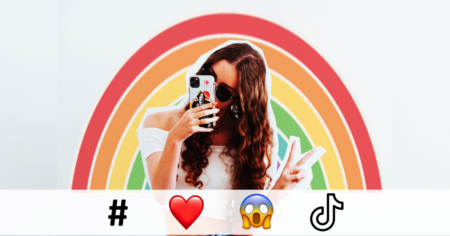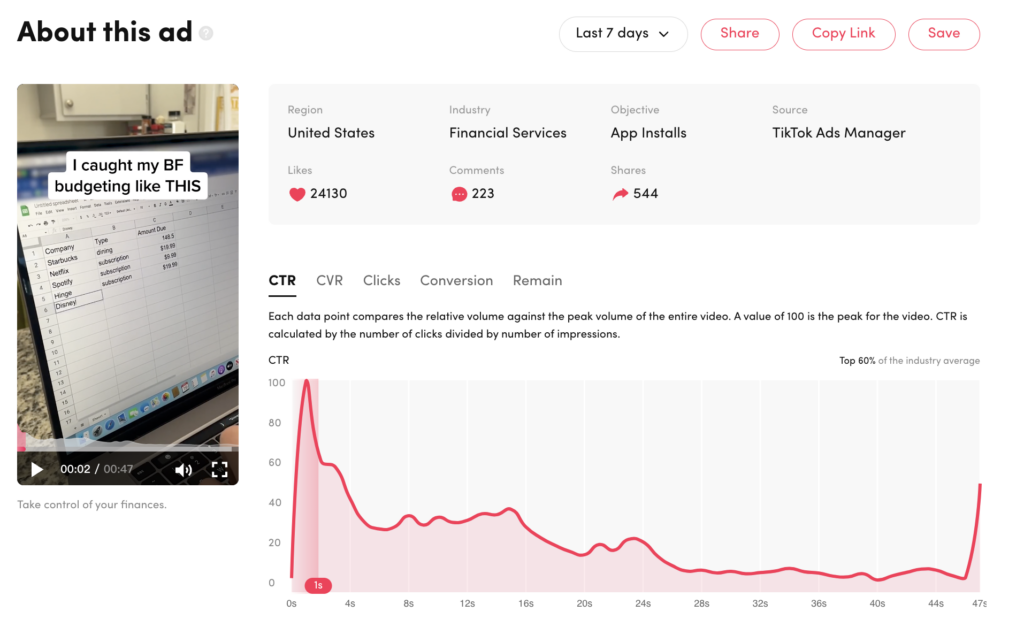With the rise of short-form video content platforms like Tiktok or Snapchat, mobile advertising has evolved to adapt to these native formats.
Hence, User-Generated Content (UGC) ads have quickly become one of the most used creative types in 2023 for mobile user acquisition.
In UGC ads, the content of the ad is created by a person (an existing user, a random person, an influencer, or even a celebrity), rather than by the brand itself. These ads are shot in real life (although they can also feature gameplay cuts/footage) and leverage the trust and authenticity of having a real person talking to the audience.
UGC ads can come with various concepts, such as tutorials, quizzes, music performance – we will review the top UGC concepts in this post.
In mobile gaming, UGC ads are a great way to diversify creative types and optimize for UA performance on various ad channels.
In this post, we will dive into the growth of UGC ads, the reasons behind their success, and the different types of UGC ads to test and try.
Get ready to discover why you should double down on UGC in 2023, and how you can make it a success with in-depth UGC creative analysis!
The growth of UGC ads
The broader User-Generated Content (UGC) term describes digital content created and shared by users, and is starting to take over the world of advertising by storm.
In the gaming industry, UGC-led games like Fortnite, Roblox or Minecraft have become massive successes. So, it’s no wonder that the concept has spread.
In advertising, UGC ads first started appearing in Snapchat, and became popular with the rise of TikTok.
Now, advertisers are pushing their UGC ad concepts to other platforms like Facebook and YouTube. In fact, if a UGC ad is proving effective on a platform like Tiktok, it’s strategic for a publisher to test it on other ad channels too!
UGC ads on the rise
- In a recent study by SocialPeta and AdQuantum, UGC creatives saw a 50% increase from H2 2021 to H1 2022.
- The Influencer Marketing Industry is set to grow to $16.4 Billion in 2022, with more than 75% of brand marketers intending to dedicate a budget to influencer marketing.
- Apptamin, a leading app marketing agency, has classified UGC ads as one of the top four trends for 2023 in the mobile game ad space.
The growth of UGC ads is thus particularly strong in the mobile gaming industry where ad creatives are so critical to success, and publishers are producing a large number of creatives every week (to counter the effect of privacy regulations).
Why are UGC ads so Successful?
- Search for authenticity:
To users, UGC ads feel authentic and organic because they feature “real people”, it is less of a hard sell experience for them. UGC helps in “humanizing” an app or a game to be closer to the target audience. The ad creative is not just showing a screen or gameplay footage, but also a real-life situation with humans.
It helps the user to better identify with the person using the app/playing the game, so that the publisher can be “closer” to the user, bringing a more realistic perspective.
- Cost effectiveness
Producing a UGC ad can be incredibly cost effective, as anyone can easily make one. The prices vary from $0 to $1000+ for a UGC ad creative (without a known influencer – brands spend an average of $174 per UGC creative), but overall the production cost is much lower than, say, building a CGI ad. It’s also a lot faster to produce.
Many traditional advertising agencies with more expensive fees are now competing with a range of new UGC-specialized agencies that can scale UGC ad production at a fraction of the cost.
See for example UGC ninja with prices starting at $624 per ad.
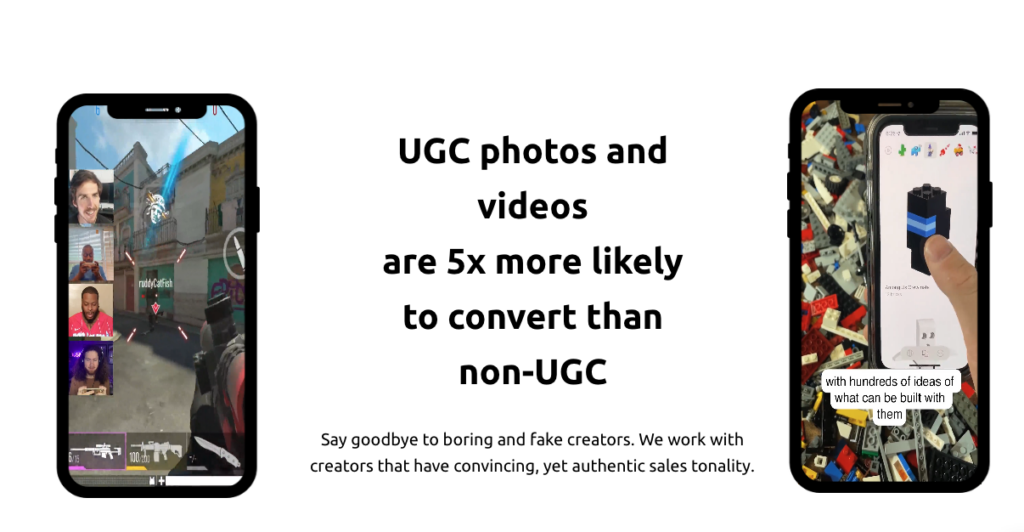
Influencer Marketing Hub recently selected the top 11 UGC agencies that publishers can partner with, to make UGC content fast, and at scale.
- User Acquisition effectiveness
UGC ads are trending not just because they are easy, quick and cheap to make, but also because they’re incredibly effective for marketing performance!
A report from Comscore showed a 28% increase in conversion with UGC content.
RealEyes found UGC ads to hold user attention 20-50% better than conventional ads.
Grand View Research found User-generated video content has been shown to drive 12 times more engagement.
- Get learnings from users
As more UGC ads are being tested, brands and publishers can better understand what best resonates with their audience. They can gain insights, through UGC ads, about what is most important to players.

For example, does a UGC ad showing a game routine for an idle RPG work better than a UGC ad featuring a competition between two late-stage players?
Based on their performances, UGC ads can really help fuel insights about users’ expectations of an app or game. They can provide ideas about possible iterations, new updates and features, as UGC ads can help uncover effective use cases.
The different types of UGC ads
UGC ads can be categorized into different types. Creators have their own unique style and approach, however, some concepts are often repeated. Here are some of the most popular types of UGC ads – many advertisers will combine different types as well:
- How-to tutorials: The creator provides step-by-step instructions for an app or game, making the ad quite informative.
- Transformations (before/after): The creator showcases a change – either before/after playing a game, or referring to a transformation within the game.
- Testimonials: Testimonials are the most common type of UGC ads: the creator shares the experience of an app or game and lists all the benefits. There are three types of testimonials:
1. Faux testimonials using actors to deliver key message
2. Actual testimonials with real users to deliver key message
3. Influencer testimonials using paid celebrities to deliver key message
- Day in the life of: This type of UGC ad features a creator who describes a typical day with routine activities that directly/indirectly mentions the promoted app or game.
- Incredible story (“what happened to me”): The user tells a story or experience that involves the app/game (example: “I was so focused playing game X that I got locked in an airplane”).
- Commenting while playing the game: It’s a very common UGC creative type where the creator(s) are seen playing the game and comment/react to what they see. This type of creative is inspired from livestreams on platforms like Twitch.
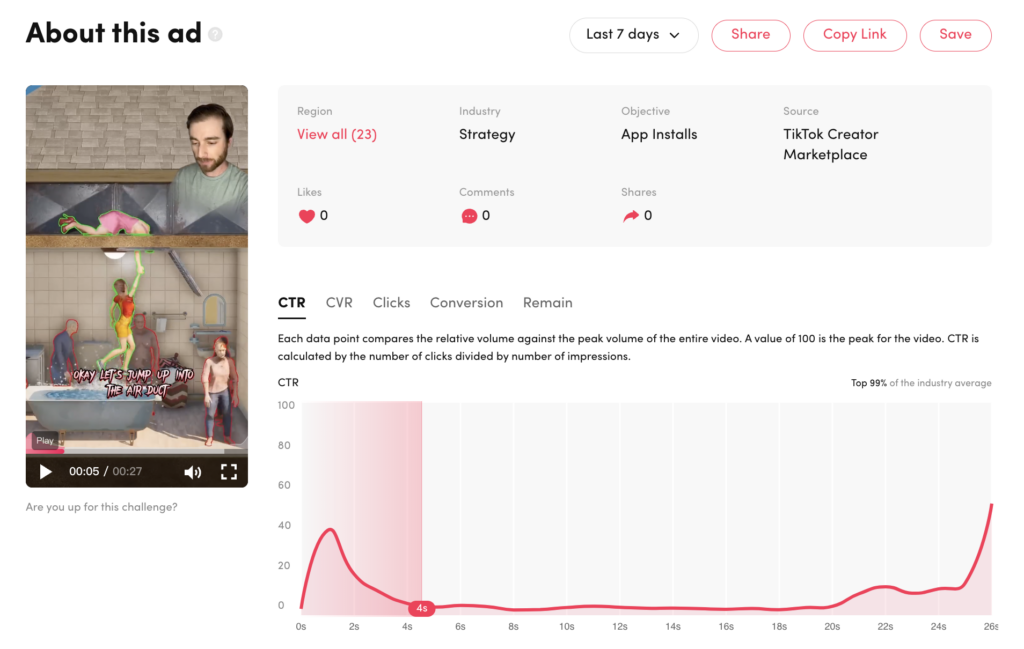
- Explaining the concept/story of the app/game: The creator explains in his/her own words what the app/game is about. It gives the user a clear and snap understanding of the game/app.
- Split screen with gameplay: In terms of format, many UGC creatives involves either a split screen (creator on one side, mobile app/game footage on the other) or green background so that the creator appears at the foreground, with the mobile app/game footage in the background.
- Cosplaying/Costumes (even the most unexpected cosplays): The creator dresses up as characters from the app/game and builds a mini storyline related to the app/game. The creators can also act out characters from the app/game in real life.
- Questioning an individual: The creator asks questions to another creator that have a direct/indirect relations about the app/game (e.g. what’s your favorite character in game X?”). The answers are often spontaneous and genuine, so that the ad feels more immersive to the viewer.
- Singing, poetry, and other performance: the creator uses a performance, such as dance or any other form of expressions and incorporates a direct/indirect mention of the app/game in it.
- Tips & Quizzes: The creators gives “tips & tricks” about a game and app, or questions the viewer about the game/app – the idea is to make the viewer feel like he can become an expert in the game/app by following these recommendations.
- Copying Tiktok Trends: TikTok trends are rapidly changing and numerous. They all have a clear concept that can be copied and applied to promoting an app/game. For instance, one recent concept was “Tell me without telling me” videos where creators have to explain/show a concept without actually saying it.
Tips to optimize your UGC ads
- The featured actors should look like your target audience:
The more similar your featured actors (influencers, creators, etc.) are from your target audience, the more likely they’ll drive app downloads. Use creators and influencers that can have a strong appeal to your audience – this requires learning as much as possible about your target audience demographics and likes.
For example, Angry Birds used Yoga influencers to appeal to users who are looking to relax, surfing on the ASMR theme (Game > Help to relax > Yoga).

- Build UGC creatives based on personas:
Once again, the more you know about your target audience, the more insights you get about the types of UGC content that will work well. Using Facebook’s Big Catch playbook can help you better define your target audience.
For instance, if your players’ motivation is mainly focused on “Power”, UGC ads that will be based on this concept – e.g. two people competing in the game, tips to get to a more advanced level – will work better.
On the other hand, if your player’s main motivation is “Self-Expression”, then UGC ads that will show creators being innovative and creative within the game or in real life (say, with costumes, or performances) will work better.
Tailoring your UGC ads (and your campaign targeting) to your audience’s motives and psychology will be key to getting higher engagement and conversion rates.
- Ensure authenticity:
A UGC ad is definitely not an ad with a creator pitching an app/game with a pre-defined, advertising-focused speech. The creative and the speech needs to flow naturally and feels organic and authentic. It’s the core promise of UGC ads to feel native to social media and not clearly look like an ad.
The more natural your UGC ad, the more trust you’ll get from the viewers. Possibly, the most organic UGC creatives can get you better quality users (you can verify this with Replai’s UA dashboard).
- Respect ad format guidelines:
Ad channels where UGC ads work the best, like Tiktok or Snapchat, have a series of best practices when it comes to ad formats.
It’s important to respect ad format guidelines that works best with UGC ads – mainly: vertical videos (a must), trending music (you should test what music has the best impact on ad effectiveness), look and talk at the camera (in case of selfie-style UGC content).
- Localize your UGC Ads:
UGC ads can help you drill into a specific country or market if you decide to use a local creator/influencer. You can use the same ad concept across countries (if you’ve identified a concept that worked well), but have local actors who will know better how to address a local audience.
- Benchmark UGC content and ads
UGC ads made by competitors or any other industry actors can be a great source of inspiration to build your next creatives. Replai recommends the Tiktok ad library to get inspired by UGC content, on top of Replai’s creative market insights that identify UGC ads within your competitors’ ad creative sets.
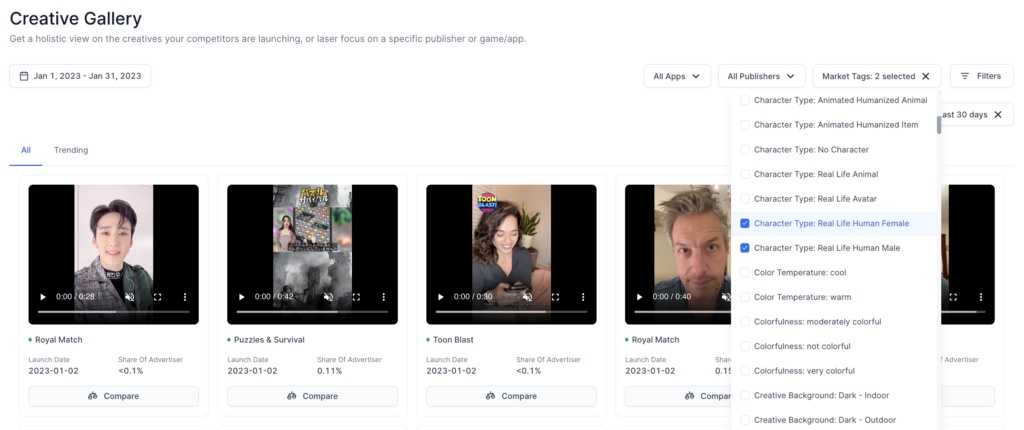
New trends are popping up every day and the Tiktok creative center with its “trends” tab can help you to pick up the right concepts, hashtags, songs and creators for your next creative.
- High emotion in the first 5 seconds:
Every ad channel recommends maximizing the impact of the first 5-6 seconds of your ad creative. In a UGC ad, you should aim for emotion to pick interest immediately – start with an engaging voice, or loud intro music, or appealing visuals with accompanying explainer text.
- UGC ads for cross-channel promotion
Although UGC ads are native to Tiktok and Snapchat, you should always think of testing these creatives on other ad channels, particularly on Meta and Youtube (where “Reels” and “Shorts” features have been added to the respective platforms to compete with short video content companies).
However, the reverse may not be true – i.e. non-UGC ad creatives from channels like Facebook may not work well on Tiktok or Snapchat, where native formats are much preferred.
The differences between creators and influencers
One question that app publishers will automatically ask themselves when build a UGC strategy, is wether they should go for creators or influencers.
In general, marketers make a decision based on budget, availability and timelines.
The case for creators:
Creators are often easier to contract, and will produce creatives at a quicker pace. Their terms are generally more flexible, making them easier to work with. Also, advertisers can have more control over the creative process of the UGC ad and give more detailed briefs on how they’d like the creative to look like. Advertisers may want to fully orient the creative process with a creator, or let the creator be more imaginative.
Besides, creators are generally much cheaper, with fewer legal considerations to take into account.
The case for influencers:
Influencers have a specialty and an established authority over a given audience. They may bring their own “brand” to the game and thus can have a bigger impact on a target audience who already knows and follows them.
The issue with influencers is that they may not necessarily want to openly advertise an app or game, for fear of being criticized by their fanbase. They may also have more restrictions on what type of UGC creative they are willing to make. Finally, there are more legal considerations as more famous influencers are represented by agencies, making it less flexible for an advertiser to resort to a reknown influencer.
Many app publishers favor smaller influencers who can still have a significant impact on audience engagement and conversion rates. Take this example for a campaign run in Poland, where the view-to-install ratio was 5x higher with a micro influencer than with a tier-1 influencer on the same campaign. It’s all about the match rate between the influencer and your target audience, not the number of followers of the influencer.
Using celebrities
Another option is to use a celebrity service like Cameo. Many app publishers have resorted to this platform to purchase the service of a famous person at a cheap cost. Since you can ask the celebrity to say whatever you want in front of the camera, it’s a cost-effective and quick way to produce a UGC creative featuring a famous person that could resonate with your audience.
Which company to partner with for UGC ads?
The marketplace to build UGC ads is growing by the day, with industry actors having their own stance in the market.
You have all sorts of options available, between agencies providing fully integrated, managed services (such as inbeat agency) or easy-to-customize actor reaction videos (such as babblestock).
This list of the top 19 UGC ads platforms is a good starting point for mobile marketers.
If you’re mainly looking for the right influencers/actors, you can search in marketplaces like GRIN or Modash – however, you will have limited control over the final output.
If you want to work with your own creators and have more control over the overall creative, a platform like Backstage or Social Native will be more adapted. You’ll need to have a more complete brief, with clear details over budget, storyline, and background (if you want to reuse a cut in different situations be sure to shoot with a green screen).
The next trend? UGC with Playable Ads
In his 2023 predictions for User Acquisition, Matej Lancaric forecasts the resurrection of playable ads that can be combined with UGC elements.
This new format involves a person reacting to how the user is playing the ad. The idea has a lot of potential and isn’t yet fully exploited in the mobile gaming industry. You can imagine a real person reacting positively whenever the player makes the right choices in the playable, or negatively if the player is taking the wrong decision.
Such combination can create more immersive, engaging experiences – and should be tested to see if it can drive higher UA performance.
A company like Adliven has already started implementing this new format in their playable platform offering. Advertisers can easily upload and combine UGC content with their playable ads. It will be exciting to follow this trend and see who will take the concept further.
How to assess your UGC ads’ performance?
Since there are so many types of UGC ads a publisher can build, it is important to have a full understanding of what works best and have the most relevant UGC ad creative with the right audience.
First, publishers need to have clarity over the performance of their UGC ad creatives in comparison to non-UGC ads. It is important for publishers to first identify this difference in terms of marketing performance (total spend, average IPM, average CPI, average ROASD7, etc.) to see how much more effective UGC ads are in comparison to other types of creatives.
Then, mobile marketers need to assess the specific performance of their UGC ads.
There are many factors they should take into account that can have an impact on performance:
- The actor themselves
- The creative storyline
- The actor’s emotions and reactions
- The speech
- The music
- Any other overlaying creative elements (e.g. Emojis, text.).
Each of these elements can play a role on the viewer’s perception of the ad.
These creative elements need to be aggregated across all UGC ads to detect “patterns of performance”. For example, do male actors have overall better performance than female actors? Or, is there a specific call-out that works better to get app downloads?
By deconstructing their UGC ads, publishers can cross-reference performance data to identify the elements that are working the best.
Based on the first round of analysis, creative strategists can inform their roadmap to build the next UGC creatives – for instance, using the same actor that has the best results, but in a different situation/different storyline, or a different music. Iterating on UGC creatives is fairly quick and easy, which is why it should be a key area to invest in 2023!
Do you have a UGC ad strategy but don’t know how to assess their performance across the board? Contact Replai and see how our custom creative tagging will help you identify the key winning elements across UGC ads that will resonate with your audience!
